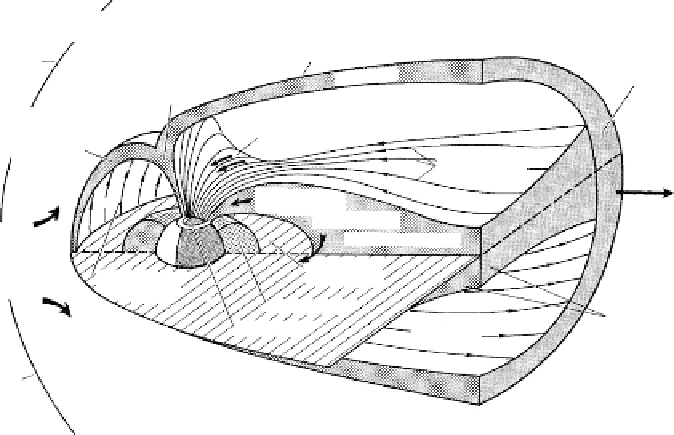Geoscience Reference
In-Depth Information
Interplanetary
medium
Magnetosheath
Magnetopause
Bow
shock
Tail
boundary
layer
Cusp
Northern
tail lobe
Dayside
boundary layer
(entry layer)
Field-aligned
currents
Geomagnetic
field lines
Magnetotail
Auroral
precipitation
Ring current
Plasma sheet
Solar
wind
plasma
Radiation
belt region
Radiation
belt region
Plasmasphere
Neutral
sheet
Southern
tail lobe
Auroral oval
Bow
shock
Magnetosheath
Figure 1.17
Schematic representation of the magnetosphere. (Courtesy of J. Roederer.)
field lines that convect back to the earth. As the hot plasma sheet flows toward
the earth into an increasing magnetic field, the differential motion of the ions
and electrons produces a ring current somewhat analogous to the interaction
between the solar wind and the magnetosphere itself on the sunward side of
the earth. Some of these hot plasma sheet particles move along the magnetic
field lines and precipitate into the atmosphere in a ring around the polar regions
called the auroral oval. This ring forms the light pattern seen in Fig. 1.6. Most
of the solar wind and magnetospheric effects occur at high latitudes, although
many interesting phenomena do extend to lower latitudes during active times.
The active region is skewed in the antisunward direction, extending to 70
◦
mag-
netic latitude on the sunward side and 60
◦
on the nightside. In this text, some
of the phenomena indicated in Fig. 1.17 will be treated in detail and others in a
more sketchy fashion. The interested reader is referred to the text by Lyons and
Williams (1984) and Kivelson and Russell (1995) for more complete treatises on
magnetospheric processes.
Particle energization processes will not be discussed quantitatively at all in
this text, but a brief sketch is in order here. Solar wind electrons have thermal
and flow energies of only a few electron volts, while the bulk flow energy of
the ions is about a kilovolt. The earth's bow shock wave, shown in Fig. 1.17,
energizes the electrons to many tens or even hundreds of electron volts in the
magnetosheath. Some of these hot electrons and ions directly penetrate into the
ionosphere in the connection process or through the cusp in the magnetic field
geometry. This precipitation of energetic particles contributes to the dayside part

Search WWH ::

Custom Search